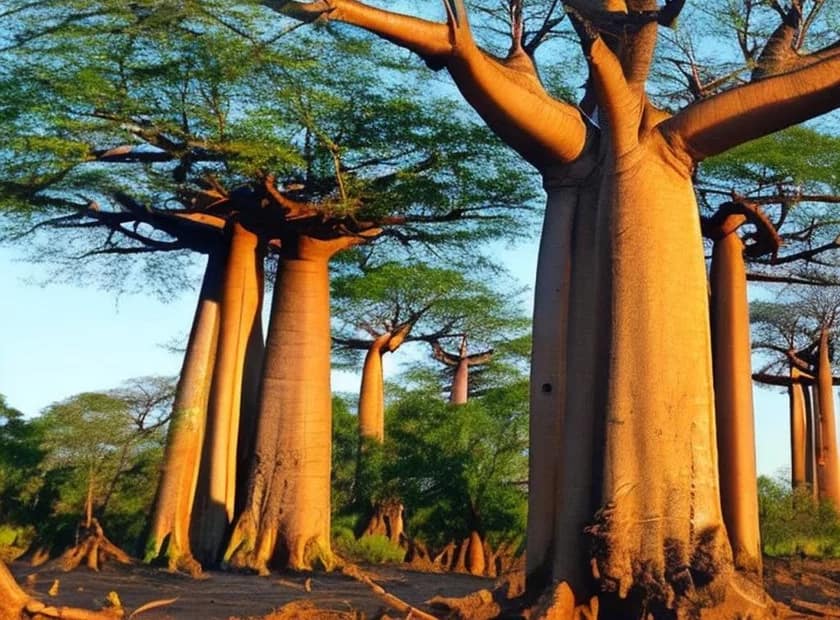The Resilience of the Baobab Tree
Long ago in the heart of Africa, the people of a small village lived in harmony with nature. They looked to the ancient symbols of their ancestors for guidance and wisdom, and in their midst stood a great baobab tree, revered as a sacred symbol of strength and endurance.
Legend had it that the baobab tree had been standing since the beginning of time, and that it held within its gnarled trunk the secrets of the universe. The people of the village believed that if they listened closely, they could hear the whispers of their ancestors in the rustling of its leaves.
One year, a great drought struck the land, and the people were left without food or water. The crops withered, the rivers ran dry, and the animals began to perish. The people prayed to their ancestors for help, but it seemed as though their prayers went unanswered.
Desperate and starving, the villagers turned to the baobab tree for guidance. They gathered around its trunk and placed their hands upon its rough bark, hoping to feel the strength and wisdom of their ancestors.
As they sat in silence, a great rumbling sound filled the air, and the ground began to shake. The people looked up in amazement as the baobab tree split open, revealing a hidden chamber within its trunk.
Inside the chamber, they found a trove of seeds, grains, and fruits, preserved for centuries by the tree’s magical powers. The people were overjoyed, and they feasted on the bounty provided by the baobab tree.
From that day on, the people of the village learned to live in harmony with nature, using the symbols of their ancestors to guide them. They respected the baobab tree as a powerful symbol of endurance and resilience, and it remained a cherished part of their lives for generations to come

Botanicals of the Baobab Tree
The Baobab tree (Adansonia digitata) is a large and iconic tree native to Africa, and it has a number of botanical components that are used for various purposes. Here are some of the main botanicals of the Baobab tree, their characteristics, and their properties:
- Baobab fruit pulp – The fruit pulp of the Baobab tree is rich in vitamin C, antioxidants, and other beneficial nutrients. It has a tangy, slightly sweet flavor and is commonly used as a natural ingredient in beverages, smoothies, and other foods.
- Baobab leaves – The leaves of the Baobab tree are high in calcium, iron, potassium, and other minerals, as well as vitamins A, C, and B. They have a slightly sour taste and are often used in traditional African dishes such as stews and soups.
- Baobab seeds – The seeds of the Baobab tree are high in protein, fiber, and healthy fats. They are often roasted and eaten as a snack or used as a natural thickener in soups and sauces.
- Baobab bark – The bark of the Baobab tree is fibrous and can be used to make rope, baskets, and other woven items. It is also sometimes used as a natural remedy for various ailments.
- Baobab flowers – The flowers of the Baobab tree are large and white, with a strong, sweet fragrance. They are pollinated by bats and other nocturnal animals.
The Baobab tree is an important source of food, medicine, and other resources for many communities in Africa. Its botanicals are valued for their nutritional and healing properties, as well as their cultural significance.
Properties of the Baobab tree and its components
| Part of the Baobab Tree | Properties |
| Fruit Pulp | High in vitamin C, antioxidants, fiber, and other beneficial nutrients. Often used as a natural ingredient in beverages, smoothies, and other foods. |
| Leaves | High in calcium, iron, potassium, and other minerals, as well as vitamins A, C, and B. Often used in traditional African dishes such as stews and soups. |
| Seeds | High in protein, fiber, and healthy fats. Often roasted and eaten as a snack or used as a natural thickener in soups and sauces. |
| Bark | Fibrous and can be used to make rope, baskets, and other woven items. Also sometimes used as a natural remedy for various ailments. |
| Flowers | Large and white, with a strong, sweet fragrance. Pollinated by bats and other nocturnal animals. |
Baobab myth
The baobab tree has several myths and stories surrounding it, including one where the god Kaang plucked the tree and threw it away from the heavens, and it eventually fell on Earth, landing upside down, and continued to grow that way. Another story says that when God planted the Baobab tree, it kept walking in the garden, so it was plucked and replanted upside down to keep it from moving.
The baobab tree has been used in African culture and traditions in various ways. The tree is considered a spiritual symbol in Senegalese and southern African cultures, and depending on the size of a community, there may be a couple of trees in any given town that people look to for spiritual connection. Dead relatives are buried at the base of these trees, where it is believed that the baobabs become imbued with their souls. The fruit of the baobab tree is used to bring high-quality nourishment to the living.
The tree is also associated with rites of passage, religious rituals, or sacred gatherings in some African societies. In African art, the baobab tree often serves as a metaphor for the resilience of individuals and communities in the face of changing circumstances. The tree is also exploited in legends and fables, where it is sometimes featured as an evil shrine.
Thank you for likes, shares and comments! 🌳🌴🌲🌵
Source OpenAI’s chatGPT Language Models, Dalle, AI trot and Fleeky
images Picsart and MIB
Invest in your future
Take time to learn
Embark on your journey in affiliate marketing and website creation alongside an incredible community and myself. Invest in your future by dedicating time to learn and earn. Take all the time you need to master the basics before aiming higher. Give it a try and sign up for free. You won't regret it! Discover the possibilities for yourself...


